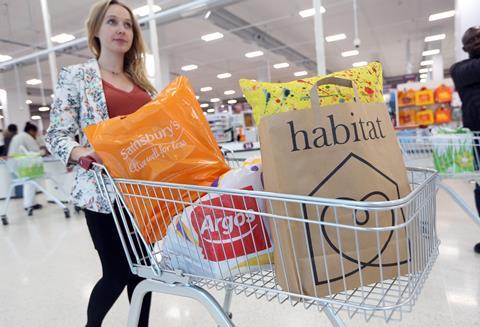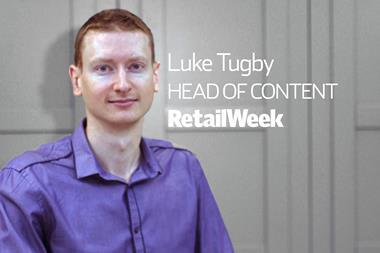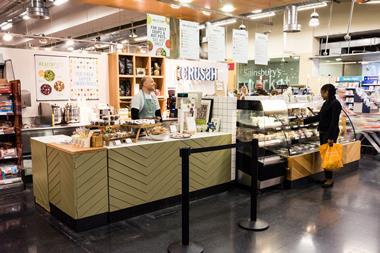Sainsbury’s boss Mike Coupe hailed a “pivotal” year for Sainsbury’s despite a third consecutive year of declining pre-tax profit.

Here are seven things we learned from the supermarket giant’s full-year results.
1. Sainsbury’s is accelerating plans for Argos
Following an encouraging first six months as bedfellows, Sainsbury’s is accelerating its rollout of Argos shop-in-shops inside its larger supermarkets.
“Supermarkets that have gained an Argos concession have reported a sales uplift of between 1% and 2% due to a halo effect”
As of its financial year end on March 11, Sainsbury’s had launched 59 Argos Digital stores inside some of its larger sheds, constituting 46 new stores and 13 relocations.
Sainsbury’s said the shop-in-shops had been performing “in line with expectations”, with like-for-like sales growth at the first 10 stores – which have been open more than a year – between 20% and 30%.
And supermarkets that have gained an Argos concession have reported a sales uplift of between 1% and 2% due to a halo effect.
As a result, the grocer is turbo-charging plans to reach its 250 shop-in-shop target – a milestone it will now hit by March 2019, some six months ahead of schedule.
Helped by the cost savings associated with operating shop-in-shops and fewer standalone stores, Sainsbury’s said its £160m target of EBITDA synergies would also be achieved six months ahead of plan.
2. The businesses are simplifying shared services
In addition to making property-related cost savings such as rent and business rates by opening more Argos concessions, Sainsbury’s said at the time of the deal that further synergies would be achieved by integrating central and store support functions across the two businesses.
“Around 40% of Sainsbury’s clothing and general merchandise lines are purchased directly from the factories that supply it, through sourcing offices in the Far East”
Chief executive Coupe and finance boss Kevin O’Byrne revealed today that progress was also being made on that front.
The retailers’ legal, safety and audit teams had already been joined up, with international sourcing offices also in the process of being combined.
Coupe said that around 40% of Sainsbury’s clothing and general merchandise lines are purchased directly from the factories that supply it, through sourcing offices in the Far East.
But that number is less than 20% for Argos, meaning it has less control over both quality and price, by virtue of paying what Coupe called a “middle man.”
Sainsbury’s existing sourcing offices in Hong Kong and Shanghai are being merged with Argos “as we speak,” according to Coupe.
3. Argos’ profit profile will not change
Despite pressing ahead with its strategy to open Argos Digital shop-in-shops, Sainsbury’s does not expect the move to have a material impact on the general merchandise retailer’s profit profile.
Historically, Argos has made its profit in the second half of the calendar year, particularly in the golden quarter as customers flock to the retailer to snap up their Christmas presents.
O’Byrne said: “Argos makes a loss in the first half because you’ve got a business with a relatively fixed cost base in rent and salaries, then makes all of its profit in the second half. The Christmas period is so important to that business.
“That profile will continue for the foreseeable future.”
4. Sainsbury’s supermarket sales declined
While its big four rivals Tesco and Morrisons continue to build momentum in their core supermarket businesses, Sainsbury’s revealed that sales achieved through its largest format slipped 2% in 2016/17.
“We can make our supermarkets more attractive, that’s what we are setting out to do”
Mike Coupe
Coupe admitted that online and convenience were the divisions seeing growth, but has plans in place to return supermarkets to positive territory.
“We can make our supermarkets more attractive, that’s what we are setting out to do,” Coupe said.
“Part of that is through general merchandise clothing and the Argos space, but equally there are things we can do within out food business and we’ve talked about things like sushi and Patisserie Valerie as being among those.”
5. More concessions and partnerships are on the cards
Sainsbury’s revealed the Patisserie Valerie deal last week and said it would open more Sushi Gourmet concessions in its larger sheds.
“We will continue to challenge ourselves to look at how we can repurpose our space to deal with the dynamics that we know are out there”
Mike Coupe
Alongside the Argos Digital implants, Mini Habitat shop-in-shops and eBay collection desks, the new concessions will enhance the overall supermarket proposition, while partnerships with the likes of Admiral and Russell Athletic in clothing have added further destination status.
But Coupe isn’t done there.
“We are looking at how we can adapt our space to provide our customers with more interest and add value to their lives. Sushi Gourmet and Patisserie Valerie are other examples of that.
“As we look forward, we will continue to challenge ourselves to look at how we can repurpose our space to deal with the dynamics that we know are out there.”
6. It won’t backtrack on multi-buys
Although supermarket sales dropped, Coupe dismissed the suggestion that the removal of multi-buy offers had a negative impact.
“Coupe said that the removal of such promotions has allowed it to better forecast shopper demand”
Some analysts, including TCC’s global insights director Bryan Roberts, have suggested that Sainsbury’s may have suffered around key periods such as Christmas by not offering multi-buys on lines like party food.
But Coupe insisted that the removal of multi-buy promotions “made little or no impact on our business overall” and refuted the suggestion that it could usher multi-buys back in ahead of events like Christmas and Easter.
On the contrary, Coupe said that the removal of such promotions has allowed it to better forecast shopper demand around peak trading periods.
“On the Friday before Easter, one of the few places you could have bought Easter eggs was Sainsbury’s. We’ve been focused on making sure that we carry the offer right the way through to the busiest weekends,” Coupe said.
“We believe that’s the right way of running the business. You’re not forcing customers to buy things they don’t want to buy, it provides more choice and it helps us reduce waste and improve availability.”
7. Sainsbury’s is eyeing the franchise model
Although Sainsbury’s is growing its convenience business at a pace – total sales from the channel jumped 6.5% during the year – the grocer is slowing its rate of c-store openings.
“That would be something where, in a relatively capital-light way, we could put our business in the future”
Mike Coupe
Having launched 41 convenience sites in 2016/17, Coupe said it would open just 25 in its current financial year, primarily as a result of there being “less good sites available.”
However, Coupe said that there were “a lot of independent sites” across the UK where he believes “the Sainsbury’s brand would play well”, and was eyeing a franchise model to take advantage of such opportunities.
“If we can get a franchise model that works for both parties – the franchisee as well as ourselves – that would be something where, in a relatively capital-light way, we could put our business in the future.”
Sainsbury’s is already piloting the franchise model having opened eight Sainsbury’s Local stores on Euro Garages petrol forecourts.
Coupe admitted that although the trial was in the “very early days”, the franchise model is one Sainsbury’s is “exploring” because it “has some attractions.”


























No comments yet